
Savior of the Bank
Alanson C. Haines, born in Newmarket on June 12, 1843, was the son of Washington and Abigail (Folsom) Haines. He attended the village schools and worked in his father’s grist and fulling mill at Crow and Eagles Falls on Grant Road on the banks of the Piscassic River. At 14 years old he attended Pembroke Academy for one term.
Civil War Veteran
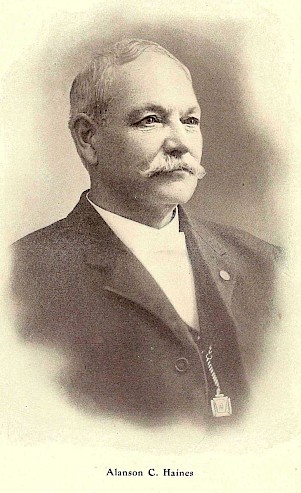 During the War of the Rebellion, he was the first man to enlist in Newmarket to answer the call for the “Nine Months’ Men.” Assigned to Co. D, Fifteenth N. H. Volunteer Infantry, August 30, 1862, he served almost a year, mostly in Port Hudson, Louisiana, mustering out on Aug. 13, 1863.
During the War of the Rebellion, he was the first man to enlist in Newmarket to answer the call for the “Nine Months’ Men.” Assigned to Co. D, Fifteenth N. H. Volunteer Infantry, August 30, 1862, he served almost a year, mostly in Port Hudson, Louisiana, mustering out on Aug. 13, 1863.
Then in 1864 Massachusetts made her call for the “Hundred Day Men.” Alanson went to the city of Lawrence where he was the first to sign the rolls. He was mustered in, July 14, 1864, as a private and was assigned to Co. K, 6th Inf. Mass. Vol. Militia; appointed corporal, he mustered out Oct. 27, 1864.
The New Market Historical Society is fortunate to have his wartime diary and many of his letters written in 1862 and 1863 from the battlefield at Port Hudson. These letters, photographs and artifacts detail his experiences during the war, and in them he lists other Newmarket men in his company and the many obstacles they all faced.
In one such letter he wrote to his father dated April 8, 1863:
“…I wrote you some time ago about Gen. Banks and his army going up to Port Hudson and what great things I thought he would do but it has turned out that he did not accomplish much. All that he did was to lose the Mississippi. I think that they had better send old Gen. Butler back here again. Gen. Banks has had all the troops that he carried up to Baton Rouge transported back to New Orleans and now is going march them or transport them across to Berwick city and then to Texas but I hope that he will do better than he did up the river. Some of the boys that belong to the 8 N.H. say that Banks had not more than 25,000 men up to Port Hudson with him.
We are having very pleasant weather here now although it is pretty warm today. We have not had any rain for most two weeks but we have very heavy dews some nights. They are enlisting negroes here to go into the regiment of sappers and miners that they are raising here. Three hundred arrived here on a steamer day before yesterday from up the river. They are giving commission to the soldiers that want them to command the negroe regiment. It has been just six months ago today since our company was mustered into the service and therefor our time will be out on the 8th day of July. We prabily shall start for home sometime in June or ought to but perhaps we may not start till our time is out. All the Newmarket boys are well. Charles Perkins eye is geting better pretty fast and he will be likely to save most the sight of it if not all of it. I am well and hope that I shall hold so at any rate till this rebellion is put down.
our time is out. All the Newmarket boys are well. Charles Perkins eye is geting better pretty fast and he will be likely to save most the sight of it if not all of it. I am well and hope that I shall hold so at any rate till this rebellion is put down.
I think that the boys that enlisted for nine months are the luckey ones for they won’t have to be drafted. The nine months boys have a better chance besides that, they have the privilege to enlist for one year and get $50. dollars bounty or they can enlist for two years and get $100. bounty. That is a privilege that thoes that are not in the service now can’t have. I hope the draft will be enforced to it fullest extent. I will send some more flowers in this letter. I have got a white rose and another red flower that I don‘t know the name of it. I will try and get some fig leaves to put in this letter. I am going to put this in the office now for I don’t know when the mail is going to leave N. Orleans and if I get another letter tomorrow I will write again. Have they heard anything from Jerry Young of late? How are all the folks around home? I must close this letter now. Give my regards to all the folks around home.
Your Son,
A. C. Haines”
His letters were donated by his great granddaughter Diana Kavanaugh Reed. Also included was the diary of Olevia Haley prior to her marriage to Alanson. The Haley and Haines families were acquainted; one entry dated Sept Tuesday September15, 1863 lists a visit to the Haines household on Grant Road after Alanson returned home from his 1st tour of duty. –
“Pleasant. I came down to Mrs Haines. Alanson is looking poorly - spend the night here they urge so hard. I visited the school this P.M. The teacher is not liked very well.”
—
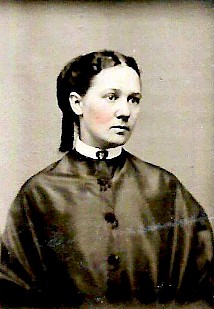
Olevia’s diary can be read in its entirety on our website or downloaded.
The link to copy is:
http://www.newmarketnhhistoricalsociety.org/site/assets/files/1017/diaries_of_s__olevia_haley_vol_1_1863.pdf
In October 1864, after his last Army discharge, Alanson returned to town and lived in his parents’ home on Grant Road. Four years later he married schoolteacher Olevia Haley of Lee who was now teaching at the Four Corner School at Ash Swamp and Grant Roads — the same school she mentioned in her diary entry above. In the 1870 census they were living in a small house on the “Epping Road” [today called Grant Road] just over the Piscassic River. Alanson was working with his brother in the grist and batting mill that his father ran.
Civilian & Professional Life
Now back in civilian life Alanson was a charter member and organizer of the local chapter of the Grand Army of the Republic when it organized on June 11, 1869 as the George A. Gay Post, No. 18. He remained committed to the organization serving in several officer positions as well as Post commander. He was also elected as Commander of State Chapter, New Hampshire G.A.R., and was involved in planning for most of the state sponsored encampments and conventions.
In 1870 Alanson was appointed assistant assessor in the U. S. Internal Revenue Service, which position he filled until the abolishment of the office. Then he served as bookkeeper for two years for the T. H. Wiswall & Co., which was his future father-in-law’s business. Thomas Wiswall owned the wallpaper and grist mills off Packer’s Falls Road in Durham. The road today is named Wiswall Road in his honor.
In June 1883, Alanson Haines was hired as a clerk in the Newmarket National Bank on Main Street. It may have helped that his future father-in-law had been a Director for the Newmarket National Bank. Two years later, Alanson’s wife Olevia died at age 41 of heart disease in August of 1885. She is buried with her parents John and Lydia Haley in the Haley family cemetery in Lee; her stone marker is engraved “”All which is real remaineth here and fadeth never”.
In 1886 Alanson’s father Washington Haines died after a long illness. In November of the same year Alanson married Clara Wiswall (1850-1935), the daughter of Thomas H. and Hannah (Thing) Wiswall of Durham. They had one daughter Hannah Haines, (1889-1961).
Clara Wiswall Haines (1850-1935) married Alanson Haines 1886
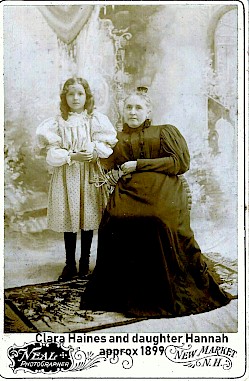 By 1900, Alanson had moved his parent’s old home from Grant Road down to South Main Street. Oxen teams moved the house with little difficulty, until the house went off the rollers as it turned Durrell’s corner unto Rt 152 (at South Main Street). It took some finesse to right the house, but all went smoothly, and the house was put in place on a new foundation at 214 South Main Street.
By 1900, Alanson had moved his parent’s old home from Grant Road down to South Main Street. Oxen teams moved the house with little difficulty, until the house went off the rollers as it turned Durrell’s corner unto Rt 152 (at South Main Street). It took some finesse to right the house, but all went smoothly, and the house was put in place on a new foundation at 214 South Main Street.
His mother Abigail moved into the home with her son and Clara.
His wife Clara was a charter member and officer of The Newmarket Woman’s Club. Their first meeting was held October 24, 1904, and fifty names were enrolled during the first few months of its existence. She later wrote that the women: “…had been Grangers, Rebekahs and W.R.C. women [ W.R.C., Woman’s Relief Corps was a woman’s auxiliary of the G.A.R.], but as club members it took time to become familiar with club work and acquainted with each other’s capabilities and qualifications.”
She was further described in the Granite Monthly as a “loyal daughter of the town, whose activities in connection with the Woman’s Relief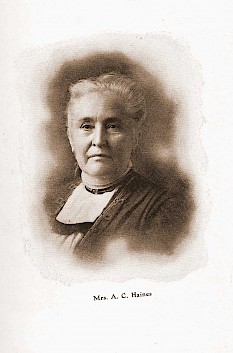 Corps and the Grange are well known. Patriotic and public-spirited to a degree, she has endeared herself to her associates in these orders. A fine parliamentarian, she presides over the affairs of the club with a quiet dignity, and gives to it her willing service and hearty support. It is, however, in her own home that she appears to best advantage, for here her charming hospitality and easy grace contribute to the comfort, happiness and hearty enjoyment of her most fortunate guest.”
Corps and the Grange are well known. Patriotic and public-spirited to a degree, she has endeared herself to her associates in these orders. A fine parliamentarian, she presides over the affairs of the club with a quiet dignity, and gives to it her willing service and hearty support. It is, however, in her own home that she appears to best advantage, for here her charming hospitality and easy grace contribute to the comfort, happiness and hearty enjoyment of her most fortunate guest.”
What the Granite Monthly did not print was the woman’s uncanny business acumen – her knowledge of stocks and bonds and how to play the market to her advantage. She was a wise investor; when her husband died in 1927 she had managed to re-invest in safe railroad stocks and much needed commodities so that she was relatively unaffected by the Crash in 1929, and her savings and investments certainly aided her daughter during the Depression.
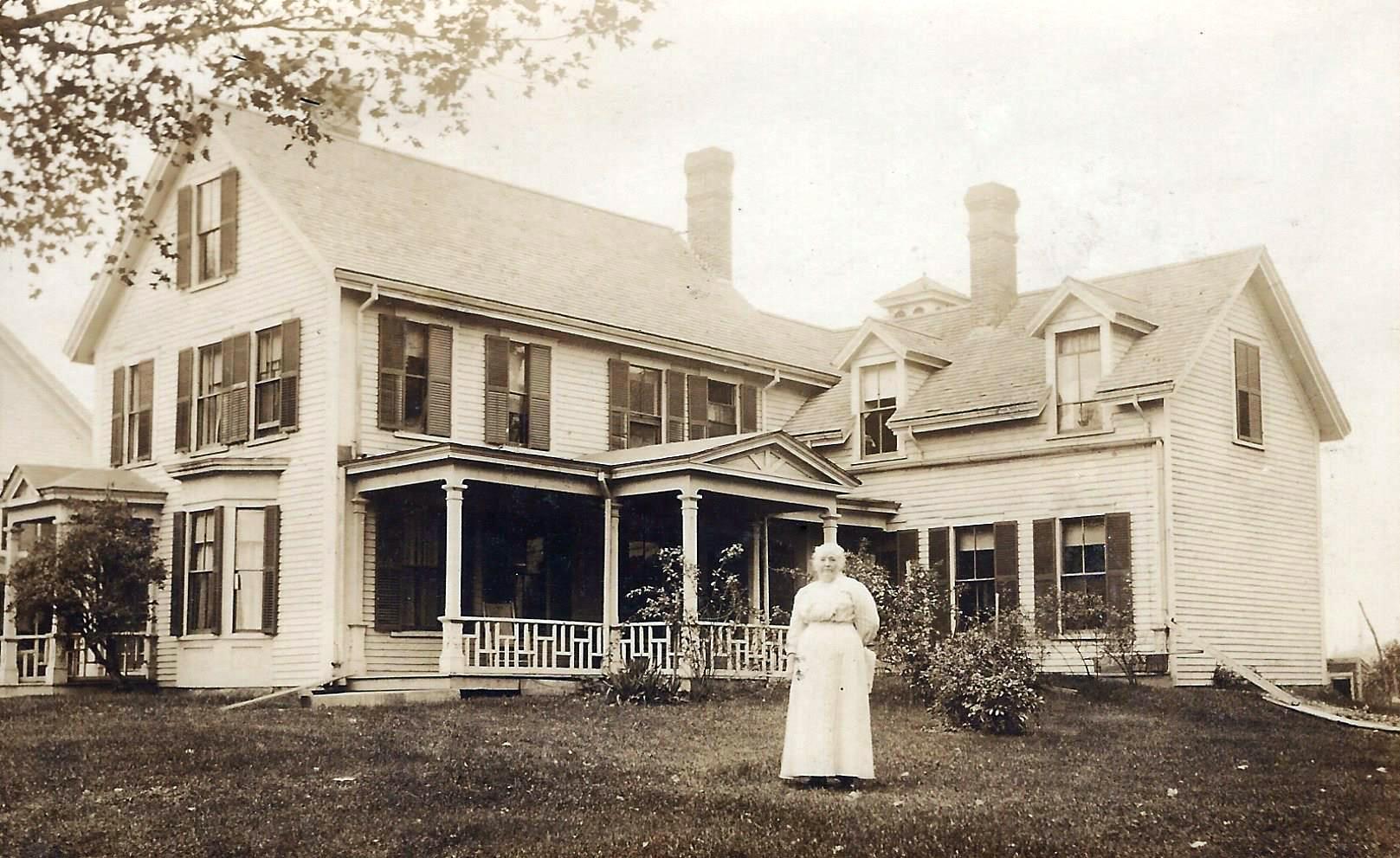
Photo of Clara (Wiswall) Haines at the 214 South Main Street residence. The house had been moved by oxen from the old Crow and Eagles Falls on Grant Road.
—
Hannah Haines Webb (1889-1961)
Hannah had her homemaking and financial training from her mother, and her patriotic feelings from her father. She graduated from Newmarket High School and attended Abbott Academy in Andover, MA. She joined the Woman’s Relief Corps as well as the Woman’s Club and the Newmarket Community Church Woman’s Guild serving alongside her mother.
 Her father taught his daughter Hannah (Haines) Webb the gravesite location of all of Newmarket’s Revolutionary, Civil War and Spanish American War veterans. She would go out to outlying graves and place a geranium every Memorial Day. She performed that duty every year except when she was living in the Midwest. She went first with her father, and then with Mrs. Fred Wright who had mapped out many of the remote family cemeteries until 1943, when Mrs. Wright could no longer accompany her. Hannah made it her lifelong goal to petition the US Veterans Bureau to obtain a military marker/gravestone, so no veteran’s grave would go unmarked. For decades she oversaw the “Decoration Day” tradition of placing geraniums on the graves of all our veterans; she drove a decorated team and wagon in Memorial Day or 4th of July parades. She was instrumental in aiding Roy Kent in his work in compiling all records of the outlying cemeteries in town.
Her father taught his daughter Hannah (Haines) Webb the gravesite location of all of Newmarket’s Revolutionary, Civil War and Spanish American War veterans. She would go out to outlying graves and place a geranium every Memorial Day. She performed that duty every year except when she was living in the Midwest. She went first with her father, and then with Mrs. Fred Wright who had mapped out many of the remote family cemeteries until 1943, when Mrs. Wright could no longer accompany her. Hannah made it her lifelong goal to petition the US Veterans Bureau to obtain a military marker/gravestone, so no veteran’s grave would go unmarked. For decades she oversaw the “Decoration Day” tradition of placing geraniums on the graves of all our veterans; she drove a decorated team and wagon in Memorial Day or 4th of July parades. She was instrumental in aiding Roy Kent in his work in compiling all records of the outlying cemeteries in town.
Hannah married Walter Webb in 1914. Walter was in the timber business and he and Hannah moved out to Nebraska and Michigan, there they had four children. At the start of the Depression Walter had lost his job and the family moved back to Newmarket to live with Clara. Hannah drove across country with four children and $25 in her pocketbook. Her husband came later. Walter remained in the timber industry in Mass & NH, active in the New England Lumberman’s Association working between Boston and Newmarket for 20 years before his retirement and move to Mt. Dora, FL. While living in Newmarket he was a deacon in the Community Church and a member of the Rising Star Masonic Lodge. He died in January 1951.
Their children: Walter Webb, Jr.(1915-2004), Louise Webb Tyler (1917- 2018), Alice Webb Kavanagh (1922-2005), Douglas Webb (1929-2000). All four children graduated from Newmarket High School, and all four were in the military during WW II or Korea. In WW II Walter Jr. served as a Captain in the Coast and Field Artillery; Louise worked for the War Department in Washington DC, with the Pentagon as a civilian while the building was under construction; and Alice enlisted in the Women’s Army Corps stationed in Italy with the 15th Air Force. The youngest of the siblings, Douglas enlisted in the US Army during Korea. Both boys joined their father in the lumber industry: Walter, Jr. in Washington State and Mass.; Douglass in Mass and New Hampshire.
—
Prior to Samuel Haley’s death in January 1892, Haines was given more responsibilities in the bank—so much so that he wrote directly and indirectly to the bank Board of Directors detailing his added tasks and his concerns regarding solvency; and he requested a raise in salary, which he received. Upon Haley’s death, Haines was appointed as head cashier – and as Head Cashier in charge of both the Newmarket National and the Newmarket Savings Bank he saw the shipwreck that lay ahead. In a letter dated February 26, 1892 – To J. C. Burley, Chairman of the Board of Directors from A.C. Haines — he gave a detailed assessment of outstanding, worthless loans made by S.A. Haley.
Haines worked tirelessly to curtail a run on the bank due partly to the national financial panic of the time, but mostly to the public reaction to Haley’s issuance of bad loans to himself and members of the Haley family. As depositors shrank total deposits down to $14,000 (leaving only a working bank surplus of $500), Haines (not unlike James Stewart in the movie A Wonderful Life) tried to soothe the fears of customers and persuade them to have confidence in the Savings Bank—this despite the ongoing investigation by the State Banking Commission, which forbade the Newmarket National Bank to do any business with the Savings Bank.
Haines wrote to the Bank Board of Directors:
“People have become frightened and with the closing of the Savings Bank caused depositors to begin a run on the National Bank, and in fact our depositors have been steadily drawing on us now for five weeks reducing us from between 50 & 60 down to about $2,700. We have got to raise money to meet them… If we can raise the money to meet our depositors, we will be all right…Respect Yours A.C. Haines. At Close of business Feb 26, 1892 Balance was $2,236.61”.
Because he was so well respected in the community, because he was not the wheeler-dealer that S.A. Haley had been, because he had not been the stereotypical bankman turned landlord with extensive holdings after picking up cheap defaulted mortgages, because he had been a veteran sloughing it out in the trenches with extensive holdings, because he was not a church-going hypocrite — he was trusted and townsfolk believed in his word. Subsequently after B.F. Haley made good on selling of his brother’s estates and after he was bolstering up the bank by selling more shares to the public, and because of Alanson’s work behind the teller’s window – the bank became solvent once more.
extensive holdings after picking up cheap defaulted mortgages, because he had been a veteran sloughing it out in the trenches with extensive holdings, because he was not a church-going hypocrite — he was trusted and townsfolk believed in his word. Subsequently after B.F. Haley made good on selling of his brother’s estates and after he was bolstering up the bank by selling more shares to the public, and because of Alanson’s work behind the teller’s window – the bank became solvent once more.
Alanson worked for 25 years as head cashier of that institution and only retired due to ill health. To him the bank owes much of its success.
He was a Republican in politics and was voted to the NH legislature in 1901. Beside his extensive work with the G.A.R., he was a member of the Grange and the Rising Star Lodge, A. F. & A. M., Orphan Council, Belknap Chapter and St. Paul’s Commandery of Dover, also 32d degree A. A. S. R.
He died February 17, 1927 after a lengthy illness. He is buried in the Haines family lot at Riverside Cemetery.